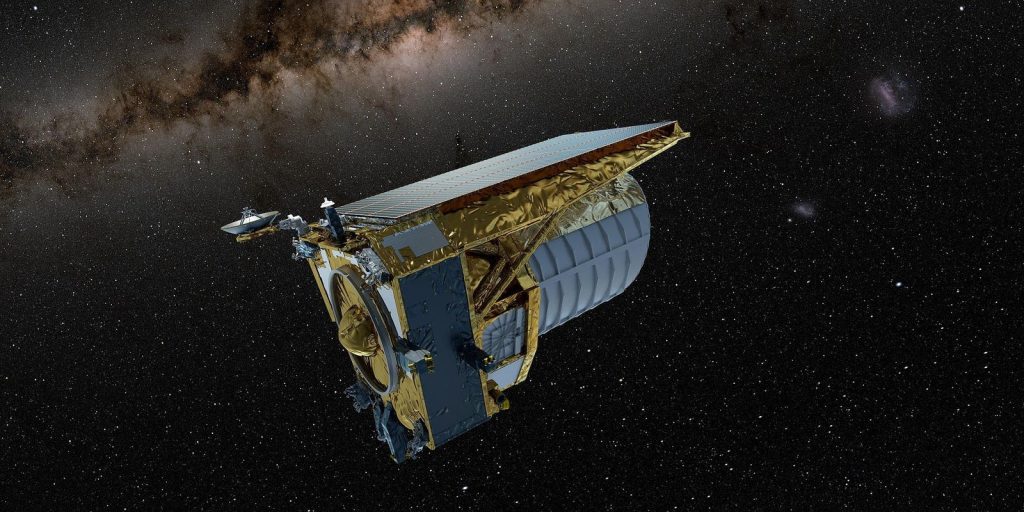Even the most successful space missions initially encounter snafus which can keep their project managers up all night. And the European Space Agency’s Euclid mission is no exception. Roughly one month after its launch this past July, the team realized that the spacecraft had issues. Ones that could jeopardize Euclid’s forthcoming wide-field survey to finally understand the cosmos’ unseen dark energy and dark matter.
High energy radiation originating both from the cosmos and from our own star’s flares —- sometimes caused artefacts or false signals to appear in Euclid’s observations, says ESA. These false signals intermittently outnumbered real stars and affected Euclid’s Fine Guidance Sensor, a finely tuned star tracker, that the spacecraft needs to fulfill its nominal six years of science observations, ESA notes.
Yet in the interim, Euclid’s Fine Guidance Sensor has been updated with new software and tested for ten days in orbit, and everything is looking good, the Euclid team notes.
Earlier this month at a media day at its space operations center in Darmstadt, Germany, ESA released five early science images that exceeded expectations.
But Is Euclid Science Already Behind Schedule?
The guidance issues meant that not all of the Early Release Observation data taken was good, so ESA only released the good ERO data on Nov. 7, Jason Rhodes, Euclid’s U.S. science lead at NASA’s Jet Propulsion Laboratory, told me via email. But there is hope that ESA can find time to retake the observations of ERO targets that had guidance problems before that system was fixed, he says.
As Euclid’s commissioning phase winds down, the next step of the mission will be to perform ‘Phase Diversity Calibration, says Rhodes. This is a procedure in which elements of the telescope are moved slightly (for instance, the distance between the primary and secondary mirrors) and then images of stars are acquired. This lets us build up a great model of the telescope’s ‘Point Spread Function’, which is the shape a point source (like a star) takes in images, he says.
The Fine Guidance System Hardware Is Working Perfectly
What we’re going to do next is take types of images that help us understand the response of the camera to images of stars, says Rhodes. That’s necessary for us to very accurately measure the shapes of galaxies, he says.
This ‘Phase Diversity Calibration’ period will take one to two months and after that Euclid will be ready to start surveying the sky at about seven square degrees per day for six years, says Rhodes.
With contributions from NASA, Euclid is a European mission, built and operated by ESA. It’s designed to map the influence of dark matter and dark energy on the visible universe (galaxies and their stars and nebulae) and thus create a 3-D map of the “invisible universe,” says ESA.
Euclid will measure the shapes and positions of about two billion galaxies over a third of the sky, says Rhodes.
Euclid May Even Spot Potentially Dangerous Near-Earth Asteroids
Although Euclid was not designed to study asteroids, it is expected observe more than 150,000 of them as foreground objects in its images.
This will produce a gold mine of data on asteroids; we will characterize smaller and more distant asteroids than possible from ground-based telescopes, Humberto Campins, a planetary scientist at the University of Central Florida in Orlando, told me via email. Euclid will see smaller asteroids throughout the asteroid belt, from just beyond Mars all the way to Jupiter, he says.
There are indications that smaller asteroids’ sample compositions are not necessarily represented among the larger ones, says Campins. Euclid will be especially diagnostic of this population of small asteroids, helping to determine if there are compositional differences with size, and what that tells us about the origin and evolution of asteroids, he says.
Euclid will also be able to characterize regions of the inner belt where Near-Earth Asteroids originate and thus what to expect when they become NEAs that could threaten Earth with impacts.
Routine Euclid Science Observations Should Soon Begin
The goal is eventually to cover 15,000 square degrees, avoiding the Milky Way and the ecliptic plane (the orbital plane of the Earth around the Sun), where extragalactic observations can best be made, Francis Bernardeau, Euclid’s scientific consortium lead, told me in Darmstadt. And he doesn’t expect routine science to begin before mid-January at earliest.
But the good news that even though the Euclid mission has a nominal lifetime of only six years, there should be enough fuel onboard to extend the mission by several years.
We’re using cold gas micro propulsion thrusters and the amount of cold gas we have on board is basically very high pressure compressed nitrogen which will effectively run out in about 11 years, Andreas Rudolph, Euclid’s flight director, told me in Darmstadt.
Read the full article here










